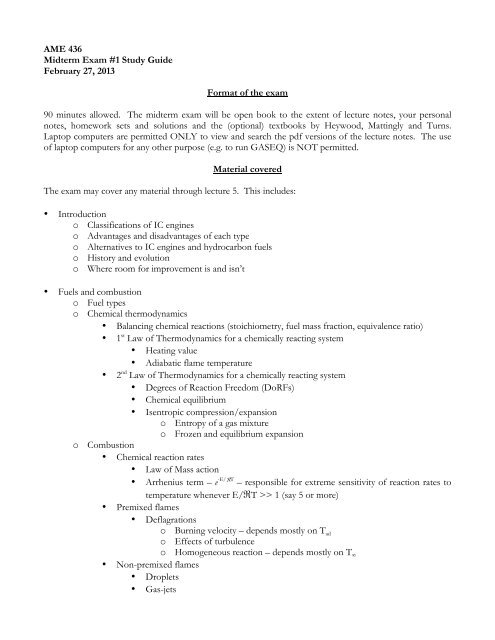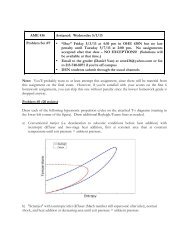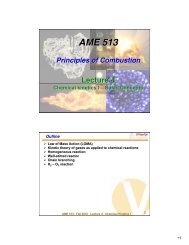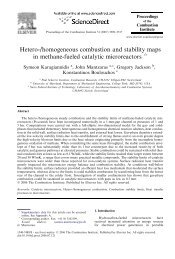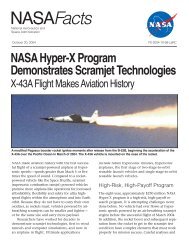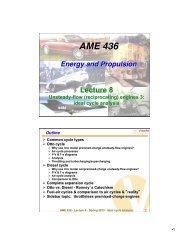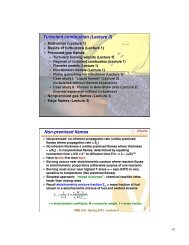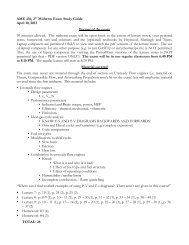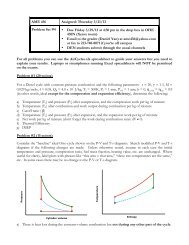AME 436 Midterm Exam #1 Study Guide February 27, 2013 Format ...
AME 436 Midterm Exam #1 Study Guide February 27, 2013 Format ...
AME 436 Midterm Exam #1 Study Guide February 27, 2013 Format ...
You also want an ePaper? Increase the reach of your titles
YUMPU automatically turns print PDFs into web optimized ePapers that Google loves.
<strong>AME</strong> <strong>436</strong><br />
<strong>Midterm</strong> <strong>Exam</strong> <strong>#1</strong> <strong>Study</strong> <strong>Guide</strong><br />
<strong>February</strong> <strong>27</strong>, <strong>2013</strong><br />
<strong>Format</strong> of the exam<br />
90 minutes allowed. The midterm exam will be open book to the extent of lecture notes, your personal<br />
notes, homework sets and solutions and the (optional) textbooks by Heywood, Mattingly and Turns.<br />
Laptop computers are permitted ONLY to view and search the pdf versions of the lecture notes. The use<br />
of laptop computers for any other purpose (e.g. to run GASEQ) is NOT permitted.<br />
Material covered<br />
The exam may cover any material through lecture 5. This includes:<br />
• Introduction<br />
o Classifications of IC engines<br />
o Advantages and disadvantages of each type<br />
o Alternatives to IC engines and hydrocarbon fuels<br />
o History and evolution<br />
o Where room for improvement is and isn’t<br />
• Fuels and combustion<br />
o Fuel types<br />
o Chemical thermodynamics<br />
• Balancing chemical reactions (stoichiometry, fuel mass fraction, equivalence ratio)<br />
• 1 st Law of Thermodynamics for a chemically reacting system<br />
• Heating value<br />
• Adiabatic flame temperature<br />
• 2 nd Law of Thermodynamics for a chemically reacting system<br />
• Degrees of Reaction Freedom (DoRFs)<br />
• Chemical equilibrium<br />
• Isentropic compression/expansion<br />
o Entropy of a gas mixture<br />
o Frozen and equilibrium expansion<br />
o Combustion<br />
• Chemical reaction rates<br />
• Law of Mass action<br />
• Arrhenius term – e -E/RT – responsible for extreme sensitivity of reaction rates to<br />
temperature whenever E/RT >> 1 (say 5 or more)<br />
• Premixed flames<br />
• Deflagrations<br />
o Burning velocity – depends mostly on T ad<br />
o Effects of turbulence<br />
o Homogeneous reaction – depends mostly on T ∞<br />
• Non-premixed flames<br />
• Droplets<br />
• Gas-jets
• Pollutant formation and remediation<br />
o Which emissions are bad?<br />
• Atmospheric photochemical cycle<br />
• Greenhouse effect<br />
• Emissions regulations<br />
o Emissions are a non-equilibrium phenomenon – if everything went to equilibrium there would<br />
be no emissions!<br />
• NO x<br />
• Thermal or Zeldovich NO<br />
o Formed at high T - very high activation energy process<br />
o Slow time scale – forms in products, not in flame itself<br />
o Lean mixtures (surplus O) favors NO formation<br />
o Rich and cool better (no excess O 2 ), low temperatures<br />
• Prompt NO<br />
o Formed in the flame<br />
o Two mechanisms<br />
<br />
<br />
Reaction between N 2 and CH or C 2 radicals<br />
Reaction between N 2 and super-equilibrium concentrations of O<br />
atoms with flame<br />
• CO, unburned hydrocarbons (UHC), formaldehyde (CH 2 O)<br />
• Formed due to incomplete combustion or “trapped” fuel (e.g. crevice volumes)<br />
• High T and excess O 2 needed to minimize emissions – oxidize CO to CO 2 and<br />
UHC/CH 2 O to CO 2 and H 2 O<br />
o Soot<br />
• Premixed<br />
• Only formed in rich mixtures, in combustion products<br />
• Critical equivalence ratio<br />
• More soot at lower temperatures because soot formation must compete with<br />
oxidation<br />
• Doesn’t depend on fuel structure because fuel is destroyed in flame front –<br />
molecules have to reassemble in combustion products<br />
• Nonpremixed<br />
• Forms on rich side of flame front<br />
• More soot at higher temperatures because no competition between formation<br />
and oxidation<br />
• Depends on fuel structure because fuel molecules not destroyed by flame front<br />
before soot can form<br />
o Cleanup<br />
• Premixed - CO, UHCs main concern<br />
• Burn at stoichiometric with EGR to reduce flame temperature<br />
• 3-way catalyst, oxidizing for CO, UHC, CH 2 O, reducing for NO<br />
• Nonpremixed – NO, soot main concerns<br />
• Can’t use 3-way catalyst since mixture is lean overall – won’t reduce NO<br />
• Need particulate traps for soot, Selective Catalytic Reduction for NO<br />
•
Last year’s first midterm exam (should look familiar…) (average was 76/100)<br />
Problem <strong>#1</strong> (chemical thermodynamics) (50 points total)<br />
On Titan, one of Jupiter’s moons, is an atmosphere of pure CH 4 at 0.05 MPa (0.5 earth atmospheres) total<br />
pressure at a temperature of 250K. Deep underground are deposits of 30 mole percent O 2 and 70 mole<br />
percent N 2 that the Titans pump out of the ground. Unfortunately, most of the O 2 /N 2 wells are located in<br />
politically unstable regions of Titan, so this O 2 /N 2 mixture is a valuable resource which they call “fuel.” The<br />
methane in the atmosphere, which they call “air,” is “free” as far as Titans are concerned.<br />
Thermodynamic data: average mixture properties γ = 1.3, R = 300 J/kgK, C P = 1300 J/kgK<br />
CH 4 O 2 N 2 CO 2 H 2 O N<br />
Δh o f (kJ/mole) -74.87 0 0 -393.52 -241.83 +472.68<br />
Molecular weight (g/mole) 16 32 28 44 18 14<br />
K (equilibrium constant) at<br />
1800K (dimensionless)<br />
7.129 x 10 -4 1 1 2.037 x 10 3 1.873 x 10 4 3.656 x 10 -11<br />
a) (10 points) What is the stoichiometric “fuel” to “air” mass ratio (FAR) assuming the combustion<br />
products are CO 2 , H 2 O and N 2 ?<br />
b) (10 points) What is the heating value (in J/kg) of the 30% O 2 / 70% N 2 “fuel” that Titans burn<br />
with CH 4 ?<br />
c) (10 points) What is the constant-volume adiabatic flame temperature of stoichiometric “fuel’ +<br />
“air” mixtures?<br />
d) (10 points) The main product of stoichiometric fuel-air combustion (other than N 2 , CO 2 , H 2 O) is<br />
N atoms, which are extremely toxic to Titans. Suppose that after combustion, the temperature of<br />
the products mixture were increased or decreased to 1800K (but still kept at 0.5 atm total pressure).<br />
Assuming that the mole fraction of N atoms (X N )
h) Length of a nonpremixed turbulent gas-jet flame<br />
i) Rate of thermal NO formation immediately behind a stoichiometric premixed methane-air flame<br />
j) Concentration of NO far downstream of a stoichiometric premixed methane-air flame, i.e. at<br />
equilibrium, assuming perfectly adiabatic conditions


